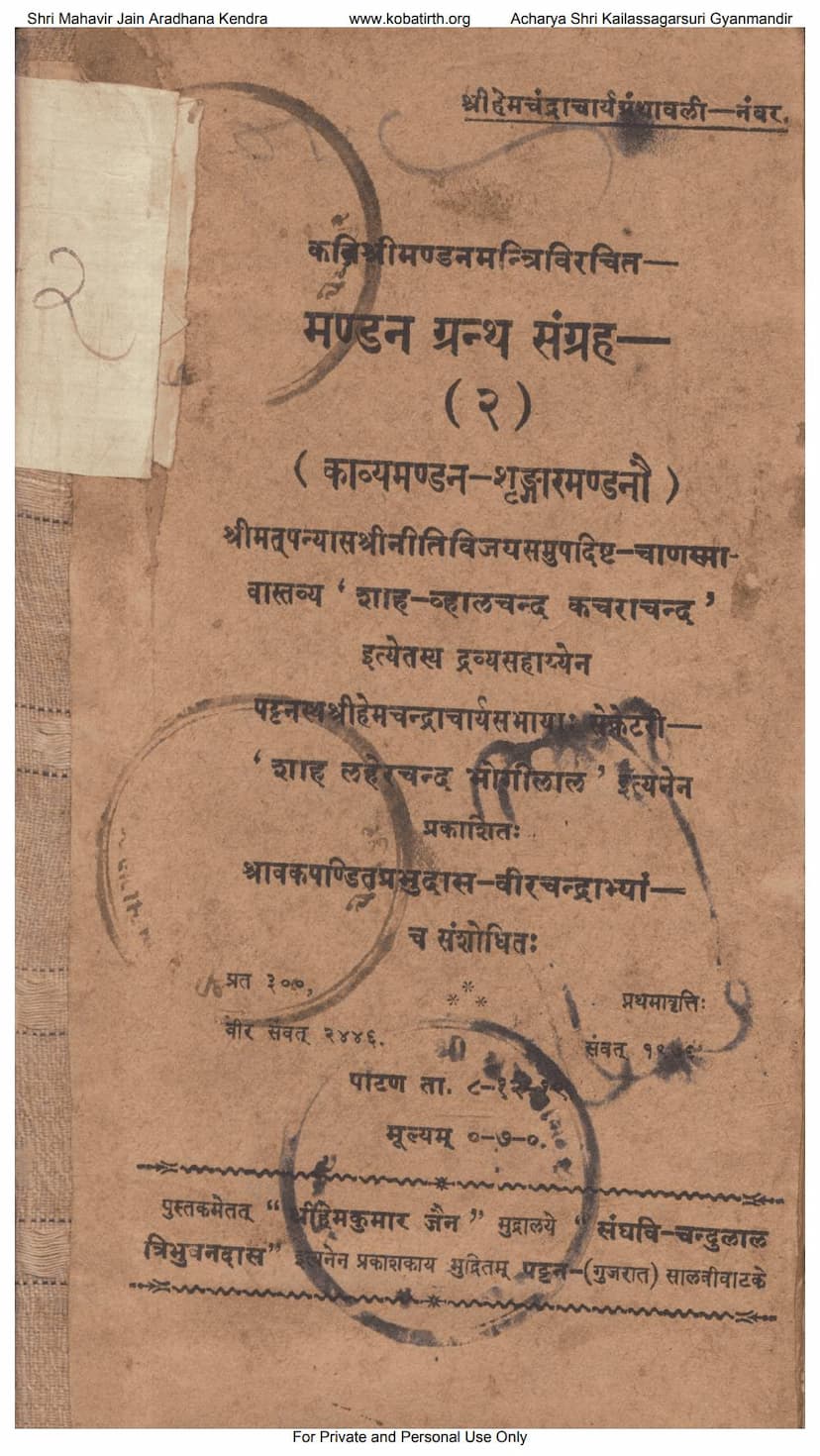Mandan Granth Sangraha Part 02
Added to library: September 2, 2025

Summary
Here's a comprehensive summary of the provided Jain text, "Mandan Granth Sangraha Part 02" by Mandan Mantri, focusing on the content of the pages provided:
Book Title: Mandan Granth Sangraha Part 02 (Mandan Compilation of Works, Part 02) Author: Mandan Mantri Publisher: Laherchand Bhogilal Shah Catalog Link: https://jainqq.org/explore/020470/1
General Overview:
This volume, "Mandan Granth Sangraha Part 02," is a collection of works by Mandan Mantri, specifically containing "Kavyamandan" (Adornment of Poetry) and "Shrigara Mandan" (Adornment of Erotic Sentiment). The preface indicates it was published in Vikram Samvat 2446 (which corresponds to 1889 AD) with the support of Shah Vahalchand Kachrabhai and edited by Shravak Panditas Prabhudas and Virachandra. The text is primarily written in Sanskrit, employing elaborate poetic language and meter.
Key Works within the Provided Pages:
-
Shri Kavyamandan (श्रीकाव्यमण्डनम्) - The Adornment of Poetry:
- Subject Matter: This section appears to be a poetic narrative detailing significant events and characters related to the Mahabharata, specifically focusing on the Kaurava and Pandava lineage and their exploits.
- Content Highlights:
- Devotional Opening: The work begins with prayers and salutations to deities, praising their virtues and power.
- Descriptions of Kings and Heroes: Extensive verses are dedicated to describing the prowess, virtues, and lineage of prominent figures from the Mahabharata epic, including Bhishma, Drona, Karna, Duryodhana, Duhshasana, Yudhishthira, Bhima, Arjuna, and the Ashvins. The descriptions are rich with epithets and metaphors, highlighting their martial skills, generosity, and kingly attributes.
- Seasonal Descriptions: There are detailed and evocative descriptions of the various seasons (Hemanta, Sharat, Pravashya, Vasanta), their impact on nature, and how they set the backdrop for the epic's events. These seasonal descriptions are highly metaphorical, often linking natural phenomena to human emotions and situations.
- Kaurava-Pandava Conflict: The verses allude to the brewing conflict between the Kauravas and Pandavas, mentioning their rivalries and the setting for their eventual battles.
- Epic Events: References are made to significant events like the departure of the Pandavas for forest dwelling, their involvement in hunting, and the general atmosphere of the era.
- Poetic Style: The language is highly ornate, filled with complex metaphors, similes, and alliteration, characteristic of classical Sanskrit poetry. The author employs a variety of meters to enhance the poetic appeal.
-
Shri Shringara Mandan (श्रीशृङ्गारमण्डनम्) - The Adornment of Erotic Sentiment:
- Subject Matter: This section shifts focus to the theme of shringara rasa (erotic sentiment), exploring the beauty of women, the pangs of love and separation, and the delights of romance.
- Content Highlights:
- Feminine Beauty: The verses offer detailed and sensual descriptions of a woman's physical attributes, including her eyes, face, hair, lips, breasts, waist, and gait. The descriptions are highly metaphorical, comparing feminine beauty to natural elements like lotuses, the moon, flowers, and rivers.
- Love and Yearning: The poems express the intense longing, the pain of separation (viraha), and the overwhelming desire of lovers for each other. The language is passionate and evocative.
- Playful Interactions: There are references to playful banter, affectionate gestures, and the intimate moments shared between lovers.
- Seasonal Influence on Love: Similar to Kavyamandan, the seasons, particularly spring (Vasanta) and the monsoon, are used to enhance the romantic mood and the intensity of emotions.
- Metaphorical Language: The author continues to use rich Sanskrit vocabulary and elaborate metaphors to portray the nuances of love and beauty. Comparisons to divine beings, celestial phenomena, and exquisite natural elements are common.
- Philosophical undertones: While primarily focused on romantic themes, some verses hint at a deeper philosophical understanding of love and existence, suggesting that true beauty and bliss can be found in genuine affection.
Author and Context:
- Mandan Mantri: The author is identified as Mandan Mantri, a poet and minister from a significant lineage (Shrimal family, son of Shri Vahada). His works are presented as part of the "Shri Hemchandracharya Granthavali," suggesting a connection to the tradition of learned scholars associated with Acharya Hemachandra.
- Jain Tradition: The preface and the mention of "Shrimal Vansha" and devotional opening suggest the work is rooted in Jain scholarship and tradition, even though the primary narrative content is from the Mahabharata epic. The publication details point to a revival or dissemination of classical Sanskrit literature within the Jain community.
Overall Impression:
"Mandan Granth Sangraha Part 02" is a testament to the rich literary tradition of Sanskrit poetry, skillfully employed by Mandan Mantri. The "Kavyamandan" section provides a poetic rendition of the Mahabharata, highlighting the grandeur of its heroes and the drama of its events, interwoven with vivid seasonal descriptions. The "Shrigara Mandan" section delves into the complexities of human emotions, particularly love and beauty, using highly aesthetic and metaphorical language. The compilation reflects a dedication to preserving and promoting classical Sanskrit literature, infused with a spirit of devotion and aesthetic appreciation.